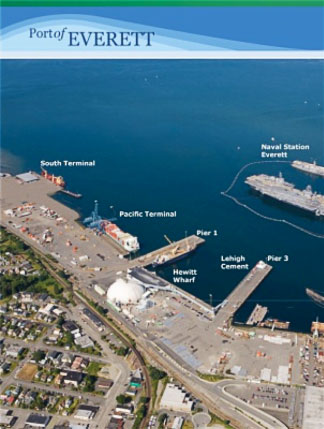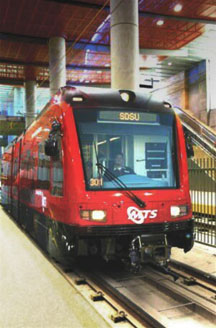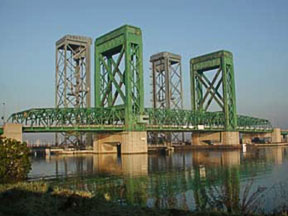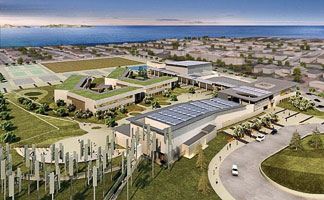Project: Risk Reduction and Air Quality Assessments, Port of Everett

Pika Environmental staff evaluated the air quality impacts of emissions associated with the construction and operation of future new rail track which would provide both a secondary pathway to move bulk cement cargo from the Port of Everett and secondary access to the BNSF mainline.
The scope of the air quality and noise analysis, for NEPA and SEPA purposes, included the reasonably foreseeable use and extension of the infrastructure improvements. However, local citizens were concerned that the increase in rail traffic could produce additional air toxics and add to the cancer burden of the neighboring community. Our staff extensively evaluated both future and projected operations and was able to demonstrate that rail transport of cement products was much more efficient than truck transport, resulting in a net reduction of diesel particulate and attendent cancer risk potential.
Our staff also updated the Ports Emission Inventory based on 2008 activity levels to provide a 2013 (project year) projection for overall Port Emissions for criteria pollutants, diesel particulate matter and greenhouse gases. Pika Environmental staff utilized port-specific 2008 activity data and included hoteling and maneuvering emissions associated with ocean-going vessels as well as harbor tugs dedicated to port barge shipments. The inventory also included on-dock cargo handling equipment, as well as rail and heavy-duty truck intermodal transport emissions.
Methodologies employed were consistent with US EPA "Current Methodologies and Best Practices for Preparing Port Emission Inventories." US EPA models including NONROAD and MOBILE6.2 were used to calculate calendar year specific emission factors for landside emission sources. IPCC emission factors and methodologies were used to develop greenhouse gas emission factors for various mobile source categories.
Project: Light Rail Construction Phase Health Risk Assessment and Mitigation, San Diego Metropolitan Transit Development Board

As part of San Diego's light rail development project, Pika Environmental staff aided the MTDB in determining the human health risks to sensitive receptors (hospital patients, day care centers, rehabilitation centers) along the rail corridor. Pika staff calculated the human health risks associated with diesel emissions and soil microbes emitted during the construction of the light rail system. These calculations were also used as the basis for retrofitting hospital and daycare HVAC systems during the construction phase of the project. Technical risk issues were successfully communicated to parents and hospital administrators in an understandable manner, gaining trust of stakeholders. These stakeholders subsequently cooperated in retrofit, operation and maintenance of HEPA filters on HVAC systems during peak construction periods, allowing both day care centers and hospitals to continue safe operations.
Project: Regional Health Risk Assessment of the SR-47 Truck Expressway, ACTA

Pika Environmental staff functioned as lead air quality expert for special NEPA/CEQA study characterizing potential local and regional health risk associated with re-routing of truck traffic along the Schuyler Heim Bridge and SR-47 truck expressway. Several design alternatives were evaluated as part of this study. In order to fully understand the magnitude of health impact and benefits, the study area was expanded to include a region bounded by the Ports of Los Angeles and Long Beach to the west, the 110 freeway to the north, the 405 freeway to the east and the 710 freeway to the south.
The health risk assessment utilized local meteorological data, AERMOD dispersion and HARP risk assessment models. The output risk estimates at specific receptors in the study region were then converted into an ARCINFO GIS visualization tool and then color coded so that areas of significant risk, concentrations approaching significant risk, minor risk increases and improvements in health risk were overlain on land use planning maps. The result was an easy to understand depiction of predicted risk that could be used in public forums to educate local residents about the nature of localized risk and the regional benefits of the improved goods movement infrastructure. These techniques were also used to provide a visual depiction of the predicted health risk benefits in future years associated with implementation of control measures in the San Pedro Ports Clean Air Action Plan as well as CARB's diesel PM reduction and low carbon fuel measures.
Project: Health Hazard Assessments of Potential School Sites, LAUSD

The LAUSD is required to characterize facilities located within a ¼-mile radius of a proposed school site that might reasonably be anticipated to emit hazardous air emissions and determine the actual or potential endangerment to the health of persons who may attend and work at the proposed project site. Pika Environmental staff have conducted visual inspections of all identified sources and obtains contaminant release information. Pika performs source characterization, estimation of ambient air concentrations, HRAs, evaluation of criteria pollutant exposures, determines accidental releases, and prepares the final assessment report. These risk assessments include an analysis of toxic emissions including diesel exhaust from both stationary and significant mobile sources of air pollution within the specified radius including freeways, rail lines and rail yards, truck stops and idling at refrigeration facilities. In addition, a criteria pollutant analysis is required for sites with freeways or major traffic corridors within 500 feet of the proposed site.

